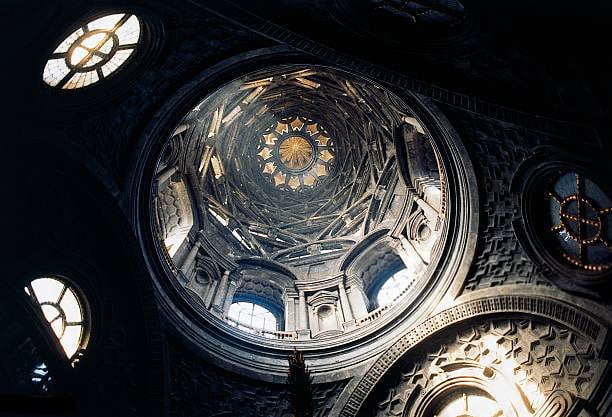
After being closed for 28 years, the Chapel of the Holy Shroud in Turin, Italy, reopened yesterday following an extensive restoration and rebuilding operation. Built between 1668 and 1694 to house the linen cloth said to have been used to wrap Jesus’s body after his crucifixion and death, the church suffered a devastating fire in 1997 and had been closed for seven years before that after a large piece of marble that fell from a cornice.
The Italian architect Guarino Guarini, a priest and a mathematician, designed the Baroque chapel, which sits behind the high altar of the Turin Cathedral, for the Savoy ducal family. It features an impressive self-supporting dome constructed with interlocking marble blocks in a complex feat of engineering.
Now that the chapel has reopened, the shroud will be returned to its traditional resting place there. (It had been stored in a different part of the cathedral during the intervening years, and was last on public view in 2015.)
The fire broke out the night of April 11, 1997, during a dinner honoring Kofi Annan, then secretary-general of the United Nations, in the adjoining palace. Firemen successfully rescued the shroud from its bulletproof, climate-controlled glass case, but the chapel was almost entirely destroyed, reduced to calcified marble fragments and melted bronze remnants. Despite investigations, no one knows the cause of the blaze, which was intensified due to wooden scaffolding installed inside the chapel due to recent renovations.
A detail of the Holy Shroud is displayed inside the cathedral of Torino in 2010. Photo by Vittorio Zunino Celotto/Getty Images.
After the fire, the restoration efforts were able to salvage some 4,000 architectural elements, but 1,150 pieces of the chapel were beyond repair and were replaced. New black and gray marble were brought in from the same quarry, at Frabosa in Piedmont, that was used during the original construction, with state-of-the-art technology ensuring that the patina of the old and new marble would match.
“This has not been a rebuilding, but a conservation project,” Luisa Papotti, the superintendent for archaeology, fine arts and landscape in the Piedmont region, told the Art Newspaper.
The €30 million ($34.9 million) cost of the renovations was mostly funded by the ministry of culture, with €2.7 million ($3.14 million) coming from the foundation of the Compagnia di San Paolo. The project, led by the architect Marina Feroggio, was plagued by delays, with the original firm in charge of construction, Corit fired and replaced by the company Arcas in 2012.
Pope Francis touches the Holy Shroud, believed by some Christians to be the burial shroud of Jesus of Nazareth, on June 21, 2015, in Turin’s cathedral. Photo by Alberto Pizzoli/AFP/Getty Images.
The shroud, which is believed to miraculously preserve an image of the face of Jesus, was one of the most important possessions of the Savoy family. They constructed the chapel so that it entered directly into the staterooms of Turin’s royal palace. (Visitors will now access the chapel through the palace, rather than from the main cathedral.)
The shroud’s authenticity, however, has been questioned for centuries, with the Bishop Pierre d’Arcis writing to the Pope that the relic was “a clever sleight of hand” all the way back in 1390, according to the Independent. More recently, carbon dating carried out in 1988 determined it was made between 1260 and 1390—but devotees of the shroud insist those results are unreliable.
People stand in front of the Holy Shroud during the Solemn Exposition of the Holy Shroud on April 10, 2010, in Turin, Italy. Photo by Vittorio Zunino Celotto/Getty Images.
The most recent evidence that the shroud is a medieval forgery comes from forensic tests conducted this year. As reported by Reuters in July, an experiment was carried out recreating the wounds said to have been suffered by Christ, and comparing the blood flow to the red marks on the shroud using Bloodstain Pattern Analysis.
“Assuming that the red stains on the Turin linen are actually blood from the crucifixion wounds, the results of the experiments demonstrate that the alleged flowing patterns from different areas of the body are not consistent with each other,” claimed the study, published in the Journal of Forensic Sciences.